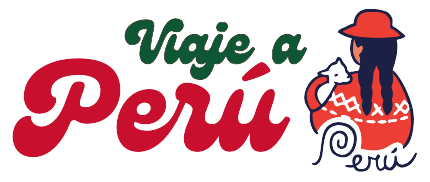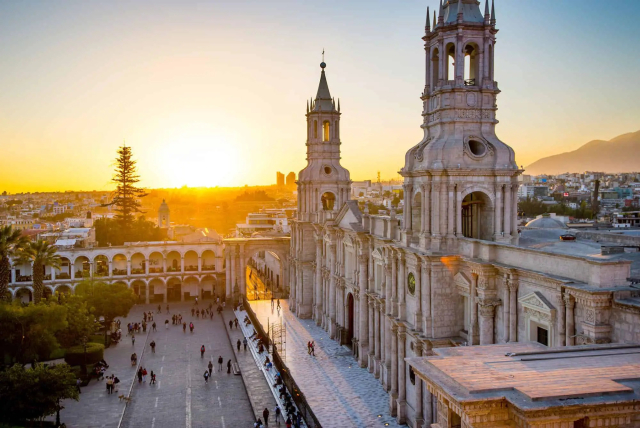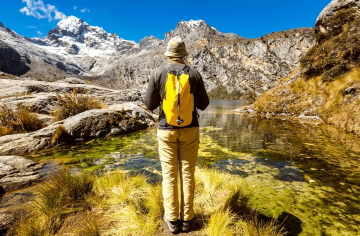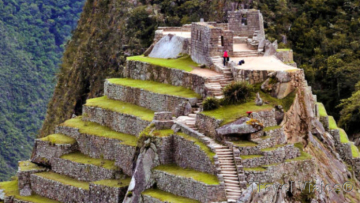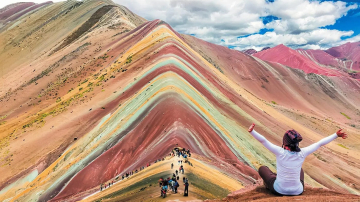Peru is a country of contrasts, where each region holds unique cultural and architectural secrets . Among its most fascinating attributes are the white cities , known for their buildings made with light-colored materials such as sillar , a volcanic stone that gives these cities a special shine . Although Arequipa , nicknamed the “White City” , is the best known, there are other less explored locations that share this unique characteristic.
In this article, we will take you on a tour of these cities , exploring their architecture, history and the charms that make them essential destinations for travelers looking for a different experience in Peru.
Arequipa: The Queen of the White Cities
The city of Arequipa , declared a World Heritage Site by UNESCO , is the greatest exponent of white cities in Peru . Its colonial architecture stands out for the use of sillar , a volcanic stone extracted from the surrounding area. This material not only gives it its characteristic white color, but also unmatched strength and elegance.
Among its main attractions is the Monastery of Santa Catalina , a religious complex dating back to the 16th century that resembles a city within a city. Also notable are the Plaza de Armas, surrounded by colonial buildings , and the Arequipa Cathedral , an architectural icon that shines under the Arequipa sun.
In addition to its architecture, Arequipa offers a rich culinary tradition . Dishes such as rocoto relleno and shrimp soup are a must for visitors to this city.
Moquegua: A Treasure to Discover
Located in southern Peru , Moquegua is a city that combines history, architecture and outstanding wine production . Although less known than Arequipa , Moquegua also has a historic center adorned with light-colored colonial buildings.
The Plaza de Armas in Moquegua is a place that reflects the splendor of its past, with water fountains designed by Gustave Eiffel and colonial mansions that are kept in excellent condition . Another point of interest is the Contisuyo Museum , where you can see archaeological pieces that tell the pre-Columbian history of the region.
You can't leave Moquegua without trying its pisco. The city is known for its traditional wineries , where some of the best piscos in the country are produced, as well as wines and macerations that delight locals and visitors.
Huancavelica: Andean Beauty and Tradition
Nestled in the central Andes , Huancavelica is a city that combines colonial architecture with dreamlike natural landscapes. Although it is not a “white city” in the strict sense, its historic center features light-colored buildings that evoke the essence of the colonial cities of Peru.
One of the main attractions of Huancavelica is the Church of Santo Domingo , a temple dating back to the 17th century and built with light stone. Also noteworthy are its thermal baths , such as those of San Cristóbal , where visitors can relax while enjoying impressive views of the mountain range.
The city is also a center of Andean traditions. During local festivities, such as Holy Week and Carnival, Huancavelica comes alive with dance and music that reflect the region's rich culture.
Cusco: Beyond the Inca Empire
Although Cusco is best known as the capital of Tahuantinsuyu and the gateway to Machu Picchu, it also has a colonial legacy worth exploring. Many of its colonial buildings are built on Inca stone foundations, creating a unique contrast.
Among the highlights of Cusco is the Cathedral , located in the Plaza de Armas . This imposing building combines Renaissance and Baroque styles , and its light stone façade gives it a majestic touch. There is also the San Blas neighborhood , known for its cobblestone streets and white houses adorned with wooden balconies.
Cusco also offers a first-class culinary experience . Local restaurants and markets feature dishes that blend traditional ingredients with modern techniques, providing a comprehensive overview of Peruvian gastronomy.
Cajamarca: History and Natural Charm
Cajamarca, located in the northern highlands of Peru, is a city where history and nature intertwine . Although it is not a white city in the literal sense , its colonial architecture features a soft color that blends perfectly with the Andean environment.
Cajamarca's Plaza de Armas is the starting point for exploring the city . Here you'll find the Cathedral of Santa Catalina, an architectural gem built in limestone . Another place of interest is the Cuarto del Rescate, the only Inca vestige in the city and a reminder of the meeting of two worlds during the conquest.
For nature lovers , the Inca Baths are a must-see . These hot springs have been used since pre-Columbian times and offer a relaxing experience surrounded by beautiful landscapes.
Peru's white cities are a living testimony to the country's cultural and architectural richness. From the majesty of Arequipa to the Andean charm of Huancavelica , each of these cities tells a unique story that connects the past with the present. Visiting these towns is much more than admiring their white facades ; it is an invitation to immerse yourself in the traditions, flavors and landscapes that make them unique.
The discovery of these lesser-known cities , such as Moquegua or Cajamarca , also invites travelers to explore beyond the traditional destinations , revealing hidden gems waiting to be admired. Planning a tour of these white cities is, without a doubt, a way to enrich your experience in Peru and take away unforgettable memories.
We invite you to learn more about Peru here: Blogs from Peru.
